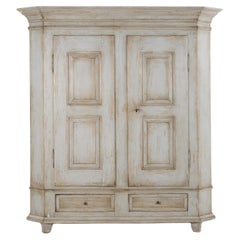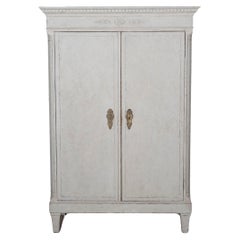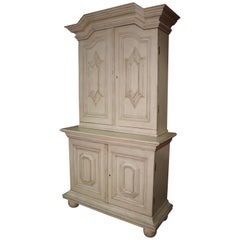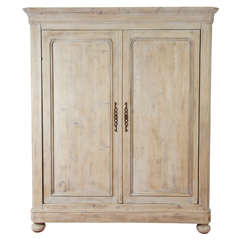Antique Gustavian Wardrobe
Antique Mid-19th Century Swedish Gustavian Wardrobes and Armoires
Metal
20th Century Swedish Gustavian Wardrobes and Armoires
Wood, Pine
Recent Sales
Vintage 1970s Swedish Gustavian Wardrobes and Armoires
Hardwood
Antique 19th Century Gustavian Wardrobes and Armoires
Pine
Antique Early 19th Century Swedish Gustavian Wardrobes and Armoires
Antique 19th Century Swedish Gustavian Wardrobes and Armoires
Wood, Paint
Antique Early 19th Century German Gustavian Wardrobes and Armoires
Wood
Antique Early 19th Century Swedish Gustavian Wardrobes and Armoires
Pine, Paint
Antique 1780s Swedish Gustavian Wardrobes and Armoires
Pine
Antique Early 19th Century Danish Gustavian Wardrobes and Armoires
Metal, Bronze
Antique 19th Century Swedish Gustavian Wardrobes and Armoires
Pine, Paint
Antique 1880s Swedish Gustavian Wardrobes and Armoires
Pine
Antique Late 18th Century Swedish Gustavian Wardrobes and Armoires
Wood
People Also Browsed
21st Century and Contemporary Philippine Art Deco Night Stands
Shagreen, Palmwood
Vintage 1950s Italian Mid-Century Modern Wall Lights and Sconces
Brass
Vintage 1920s French Late Victorian Chandeliers and Pendants
Brass
2010s Portuguese Mid-Century Modern Dining Room Tables
Stone, Limestone, Travertine, Marble
Antique 19th Century English Victorian Farm Tables
Pine
Late 20th Century American Neoclassical Tables
Concrete
2010s American Modern Table Lamps
Marble, Brass
Early 20th Century French Mid-Century Modern Fountains
Composition
2010s American Dining Room Tables
Stone, Cast Stone, Concrete
2010s Egyptian Organic Modern Vases
Alabaster
2010s Brazilian Brutalist Side Tables
Marble
Vintage 1970s Italian Modern Chandeliers and Pendants
Nickel
2010s French Scandinavian Modern Sideboards
Ash, Wood
Antique Late 19th Century French Louis XIV Commodes and Chests of Drawers
Bronze
20th Century Austrian Scandinavian Modern Chandeliers and Pendants
Metal
Antique Late 19th Century Chinese Qing Vases
Porcelain
Antique Gustavian Wardrobe For Sale on 1stDibs
How Much is a Antique Gustavian Wardrobe?
A Close Look at Gustavian Furniture
With clean lines and muted colors, antique Gustavian furniture is understated and elegant. It represents a more restrained version of the transition from Rococo to neoclassicism that was happening in France under Louis XVI. The style developed under Swedish King Gustav III, who reigned from 1771 until his assassination in 1792, and his son Gustav IV, who ruled until 1809. Although Gustavian furniture is mostly used to refer to pale painted cabinets, commodes, armchairs and other items, it involved a range of influences.
Gustavian-style furniture was inspired by discoveries at Pompeii and Herculaneum as well as the grandeur of European palaces like Versailles, with local softwoods such as pine and birch. There was also an emphasis on natural light; crystal chandeliers and large mirrors played a role in radiating the fleeting daylight of winter, giving it a distinctive aesthetic.
Where earlier furniture was curvy and florid, this new era was more architectural, with tapered and fluted legs and rectangular and oval shapes. Luminous gilt contrasted with the palette of soft blues on upholstery and painted surfaces. Leading furniture builders included Gottlieb Iwersson, Louis Masreliez and Erik Öhrmark. The latter, a French-born Swedish decorator, designed the Sulla chair, a seat that was demonstrative of technical skill and precise craftsmanship and drew on Greek klismos chairs. Masreliez’s Sulla chair was made by Öhrmark and featured decorative ornamentation produced by Jean-Baptiste Masreliez, Louis’s younger brother.
While the wealthy had furniture carved with neoclassical details like scallops and rosettes, more affordable options were adorned with faux finishes that mimicked marble and stenciled patterns. The simple elegance of Gustavian furniture would have a long impact on Swedish design, informing the 20th-century appreciation for function and form. In the 1950s, IKEA mass-produced copies of a Gustavian commode designed by cabinetmaker Georg Haupt, who created pieces for the Royal Palace, making the furniture a fixture of everyday Swedish life.
Find a collection of antique Gustavian seating, tables, decorative objects and other furniture on 1stDibs.
Finding the Right Wardrobes-armoires for You
When shopping for antique and vintage wardrobes and armoires for your home, there are several things to keep in mind, not least of which is question number 1:
What is the difference between an armoire and a wardrobe?
The difference between an armoire and a wardrobe is actually simple: An armoire is merely an ornate wardrobe. A wardrobe is a tall, streamlined storage cabinet that usually has some combination of drawers, shelves and hanging rods.
Antique and vintage armoires, on the other hand, are freestanding, heavy wooden structures that typically feature decorative metal hinges and pictorial carvings. Armoires are large cabinets that aren’t outfitted with the varied storage features that wardrobes now commonly have. Armoires often have one or two doors and a hanging bar and allow for quick access. Whether a minimalist mid-century modern wardrobe or grandiose Victorian-era armoire is the right fit for you, both are highly functional furnishings and can be a smart storage solution.
Armoires have been around since medieval times, and initially they may have housed weapons and armor. In their early days, armoires were often adorned with elaborate carvings and lavish paintings, particularly in Renaissance-era France. During the 18th century and later, armoires were widely known as “presses” for hanging clothes, and they were so large that they swallowed up the room where they stood.
In today’s modern homes, an antique armoire can be a striking, architectural work of art amid comparably unadorned furnishings. Whether you’re using your piece in the kitchen for cookware or as a food pantry, in the bedroom for clothes or in the living room as a media console, it will likely become a lovable focal point.
The evolution of the armoire can be seen in today’s corner wardrobes, which may rest on an asymmetrical base to account for corner placement, and even mirrored wardrobes, which feature a mirror affixed to the inside panel of one of the doors for convenience. Contemporary wardrobes commonly feature additional sliding trays and drawers and hanging space for clothing or linens, and the cabinet doors make them ideal for concealing televisions and computer monitors when such devices aren’t in use.
When choosing the right wardrobe or vintage armoire for your home, it’s good to have the following in mind: What are you planning to store in it? How much of what you’re storing will need to be housed in it? It should be big enough to accommodate your needs. What is the size of the room where your wardrobe or armoire will live? A large new piece of furniture in a modest space can easily become a hindrance if you have to navigate your way around it during your daily routine, so be mindful of the area you'll need in order to move freely.
Whether you are looking for an antique walnut armoire or a simple contemporary wardrobe, find the right piece for your home today on 1stDibs.



